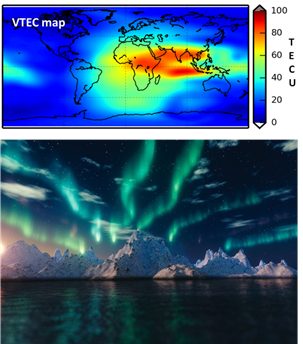Near real-time modelling of the electron content in the ionosphere

The rapidly growing number of terrestrial GNSS (Global Navigation Satellite System) receivers providing double frequency measurements in real-time and near real-time enables the computation of ionosphere parameters such as the Vertical Total Electron Content (VTEC) with increasing accuracy and decreasing latency.
Scientists of DGFI-TUM have now developed a comprehensive processing framework to compute VTEC maps in near real-time from low latency GNSS measurements using compactly supported B-splines and recursive filtering methods. Details and results are described in the article Near real-time estimation of ionosphere vertical total electron content from GNSS satellites using B-splines in a Kalman filter (Annales Geophysicae, 2017, DOI: 10.5194/angeo-35-263-2017).
Series expansions in terms of B-spline functions allow for an appropriate handling of heterogeneously distributed input data. Kalman filtering enables the processing of the data immediately after acquisition and paves the way of sequential (near) real-time estimation of the unknown parameters, i.e. VTEC B-spline coefficients and differential code biases. Under the investigated conditions, the validation tests of our near real-time products show promising results in terms of accuracy and agreement with the post-processed final products of the International GNSS Service (IGS) and its analysis centers which are usually publicly available with several days of latency.
Arcisstraße 21
80333 München